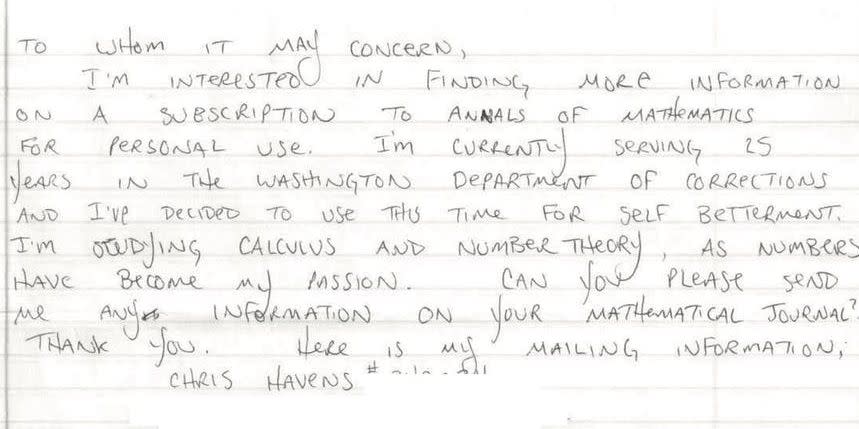How an Inmate Serving a Murder Sentence Made a Huge Math Discovery

A new number theory paper comes from three academic researchers and, astonishingly, one prison inmate.
Number theory is full of complex problems with applications in cryptography and more.
The paper is on continued fractions, which are a way to approximate irrational numbers.
Earlier this year, a first-time academic author published a new mathematical study in the journal Research in Number Theory. The twist? The researcher, Christopher Havens, is also serving a 25-year sentence in the Washington Department of Correction following a murder conviction.
Inmates often send requests to publishers and publications, because access to specific books and even entire genres of books are extremely limited in prisons. The guidelines are byzantine, and prisoner rights organizations hold up restricted access to books as an example of a violation of the First Amendment.
It’s in this context that chemist and professor Marta Cerruti’s partner received a request from Havens for an annual subscription to the Princeton-based journal Annals of Mathematics.
And it happens that Cerruti’s father is a number theorist who was willing to take a chance on Havens, who was trying to teach himself calculus and number theory without any access to a qualified teacher.

“To test him, he gave Havens a problem to solve,” Cerruti recently wrote in The Conversation. “In return, my father received a 120-centimetre-long piece of paper in the mail, and on it was a long and complicated formula. [T]o his surprise, the results were correct!”
Umberto Cerruti, who was a professor of mathematics at the University of Torino, Italy, is one of the other authors on Havens’s paper, “Linear fractional transformations and nonlinear leaping convergents of some continued fractions.”
Number theory is the study of integers and what integers can do. It’s part of discrete mathematics, which examines countable numbers like integers rather than continuous topics like calculus. (The beginning steps of learning something like a Riemann sum are pretty discrete, but the goal of this exercise is to eventually approach infinity, which is continuous.)
Continued fractions are a fun special case of, for example, irrational numbers like π that can be represented with complicated fractions that also repeat. Instead of a series of digits that continue after a decimal point, they’re fractions that have more fractions in their denominators. These get smaller and smaller and eventually converge into approximations of the irrational numbers they can represent.
“There's no such thing as a closest rational approximation to an irrational number,” math writer Evelyn Lamb explained in Scientific American. “By increasing the denominators of our fractions, we can get as close as we want.”

In their paper, Havens, Cerruti, and two other mathematicians study a linear transformation of an infinite continued fraction and draw conclusions from their findings. Then they apply those findings back to (relatively speaking) famous continued fractions.
Havens told Cerruti he went through his prison’s Intensive Transition Program:
“It's designed to effectively aid you into 'taking your head from your backside.' This was my schedule. Eat, math, remove my head from my backside, brush, rinse, repeat. It was an important time in my life."
With a scholarly publication under his belt and about 16 more years in his sentence, Havens has an opportunity to continue to grow his mathematical talents—if he can keep finding the right pen pals.
You Might Also Like

